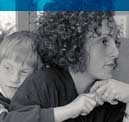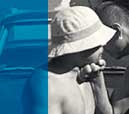      |
In the last five years
there has been a tremendous influx of immigrants into
the Lake Street neighborhoods, including: Latinos, Africans (Ethiopians,
Nigerians, Sudanese, Somalians), Russians, Bosnians, and Asians (Cambodians,
Hmong, Laotian, Vietnamese, Koreans, Tibetans) into the Twin Cities, and
into the neighborhoods connected by Lake Street. On one end, West Lake, is
the Uptown area, a trendy enclave of upscale shops and restaurants. In the
middle, East Lake, is one of the highest crime areas in the city, and also
the most diverse. Farthest east are the more blue-collar and middle-class
neighborhoods. From Old World to Third World to modern world, Lake Street
seems to include the gamut of the evolving American experience.
Lake Street USA makes photographic sense of the realities that lie behind
this experience, showing Lake Street inhabitants going about their daily
lives--on the street, in the stores, during worship, at play, at work and at
home. Some examples of the variety of subjects Huie has photographed
include: a woman getting a facial, a young man getting his tongue pierced, a
Tibetan Buddhist temple in a one-bedroom apartment, a Jewish circumcision
ceremony, a Somalian prayer group, a Hmong Pentecostal service, the Sons of
Norway, a gay, Lesbian and transgender church, a Mexican gang, families
sitting on their front steps, teenagers in their bedrooms, weddings,
funerals, the Miss Lake Street contest, a quinceañera, festivals, fights,
couples kissing, a homeless Vietnam Vet and his friends, joggers, goths,
punks, bikers, Samis, witches, shamans and just people of all kinds hanging
out.
Huie's photos will be hung in store fronts, bus stops, sides of buses and
buildings, and billboards. The entire exhibit will be visible from the
sidewalk. It will become part of the everday consciousness of Lake Street.
Competing with advertisements, it will reflect the ordinary reality of Lake
Street inhabitants. Besides magnifying Lake Street's function as a
transportation corridor, Lake Street, USA will also reveal Lake Street's
hidden function as a cultural corridor.
Huie is drawn to photographing diverse communities. In the summer of 1993
Huie started photographing the ethnically diverse, inner-city neighborhood
of Frogtown in St. Paul, where the Southeast Asian Hmong are the largest
ethnic minority. Huie spent two years photographing residents on the street,
in their homes, backyards, at barbecues, on their front porches, at play and
during worship. Huie also tape recorded interviews with residents about
their lives and the neighborhood. The results--173 photographs, many of
which were accompanied by quotes from the more than 100 interviews he
conducted--were displayed in May and June of 1995 in a vacant grass lot on
the corner of Dale and University in Frogtown.
One of the tangible effects of the Frogtown exhibition was that it helped
change people's
perceptions of the neighborhood. In a notebook laid out for comments one
person wrote, "I kept seeing people walking by or driving by that could have
come right out of the pictures. They are people very unlike me. They are the
kind of people, I admit, who I'm normally a
little afraid of. Your humanistic art has helped me a little bit to not be
afraid."
Changes in perception also led to economic development. Kenrie Williams, a
District VII
Council employee, said that District VII had had a difficult time getting
banks to invest in
housing redevelopment in the Frogtown neighborhood. But after the
extraordinary widespread media attention that the exhibition received, "the
banks came a running."
In 1996 the Minnesota Historical Society Press published that exhibition in
a critically acclaimed book titled, Frogtown: Photographs and Conversations
from a Neighborhood. It is used in many school classrooms and this year is
required reading for a Hamline University course.
But the most energizing feature about the Frogtown project remained its
public display--the quirkiness of its 24 hour access and the way it
attracted different people to a neighborhood they otherwise might never have
visited. That possibility is continued and expanded in Lake Street, USA.
Though the Frogtown exhibit was hugely successful, Lake Street, USA is much
larger in scope and much more ambitious. Besides the larger number of
photographs and interviews, Lake Street, USA will depend on an extremely
complex network of public spaces. Each space--bus stop, store front,
building wall--will require individual negotiation with a wide variety of
Lake Street residents, merchants, and public officials. These negotiations
are the social infrastructure of the exhibit and represents another
opportunity for the Lake Street community to shape its own representation.
Lake Street, like Frogtown and other inner-city neighborhoods, suffers from
perceptions that are usually beyond community control. Because of these
perceptions the people who live in these areas become somehow different,
separate from the rest of American life. Lake Street, USA will help close
the gap between perception and reality and the gap between "us" and "them"
by providing revelatory glimpses into the lives of thousands of its
residents.
Much of what comprises a community is hidden from public view. And what is
publicly seen is often ignored. Minorities, recent immigrants, and other
disenfranchised groups especially become invisible. The hope of this exhibit
is to show not only what is hidden, but what is plainly visible and seldom
noticed.
|
|
|||
|
TOUR Begin Tour |
STORY About the Artist About the Exhibit |
DISCUSSION Message Board Live Chat |
MyEXHIBIT View MyExhibit |
PARTNERS Walker Art Center/ Gallery 9 Sponsors ATI |
AUCTION Auction Info |
LAKE CAM View |
HOME |
| Technical Sponsors: |
|
| © 2000, Lake Street, USA Online. | |